Worried about tattoo risks? Learn about infections, allergies, and side effects. Get science-backed safety tips for healthy tattoos and proper aftercare.
Did you know that over 145 million Americans have at least one tattoo? That’s nearly half the population choosing to permanently mark their skin with ink. While tattoos have become mainstream, many people don’t fully understand what happens during the tattooing process or the potential tattoo side effects they might face.
Getting a tattoo involves using needles to inject ink deep into your skin’s dermis layer. This process creates small wounds that need time to heal properly. Like any procedure that breaks the skin, tattooing comes with certain tattoo risks that everyone should know about before visiting a tattoo shop.
Understanding these risks isn’t meant to scare you away from getting body art. Instead, knowing about possible complications helps you make informed decisions and practice safe tattooing. When you’re aware of what can go wrong, you can take steps to prevent problems and enjoy your tattoo safely.
In this guide, you’ll learn about the most common tattoo side effects, how to handle complications if they occur, and most importantly, how to choose a reputable artist and follow proper aftercare to minimize risks. Let’s explore everything you need to know for a safe tattoo experience.
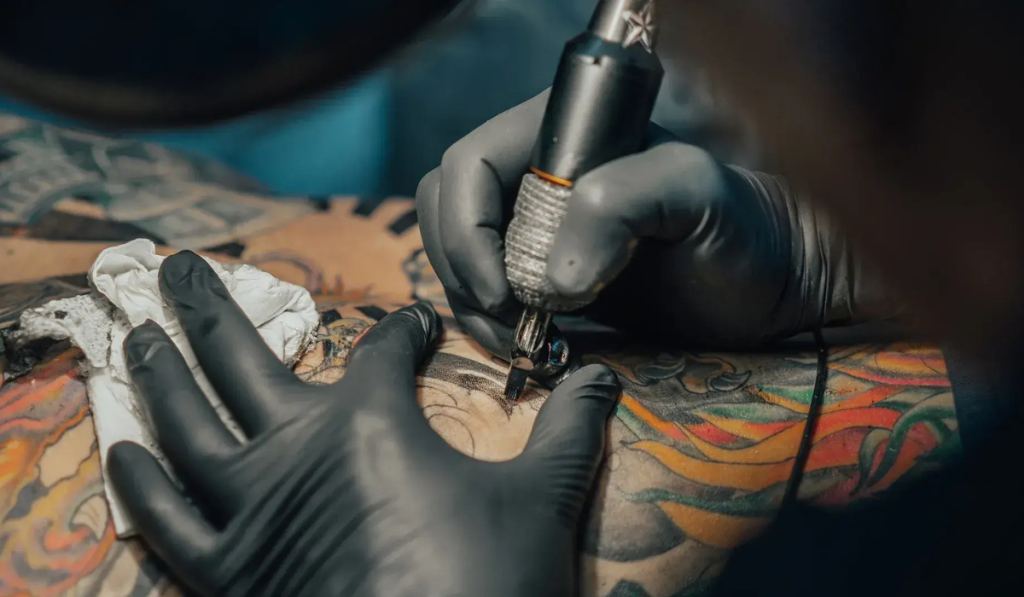
Common Tattoo Side Effects and Risks: What You Need to Know
Getting a tattoo means putting your body through a process that involves needles, ink, and healing time. While most people heal without problems, it’s important to know what side effects might happen. Understanding these risks helps you spot problems early and take action if needed.
Immediate Side Effects: What Happens Right After Getting a Tattoo
Normal Tattoo Pain and Discomfort
Right after getting a tattoo, your skin will feel sore and tender. This tattoo pain is completely normal because the tattoo needle has been poking your skin thousands of times. The pain usually feels like a sunburn or scrape and can last for several days.
Some people experience more pain than others, depending on:
- Where the tattoo is located on your body
- How big the tattoo is
- Your personal pain tolerance
- The tattoo artist’s technique
Swelling and Inflammation
Your body sees the tattoo process as an injury, so it responds by sending extra blood and fluid to the area. This causes swelling that can make your tattoo look puffy or raised. The swelling typically peaks within 24-48 hours and then slowly goes down over the next few days.
Bleeding and Bruising
Some bleeding during and right after getting a tattoo is normal. Your skin might also develop bruises, especially if you have sensitive skin or take blood-thinning medications. Light bleeding should stop within a few hours, and any bruising usually fades within a week or two.
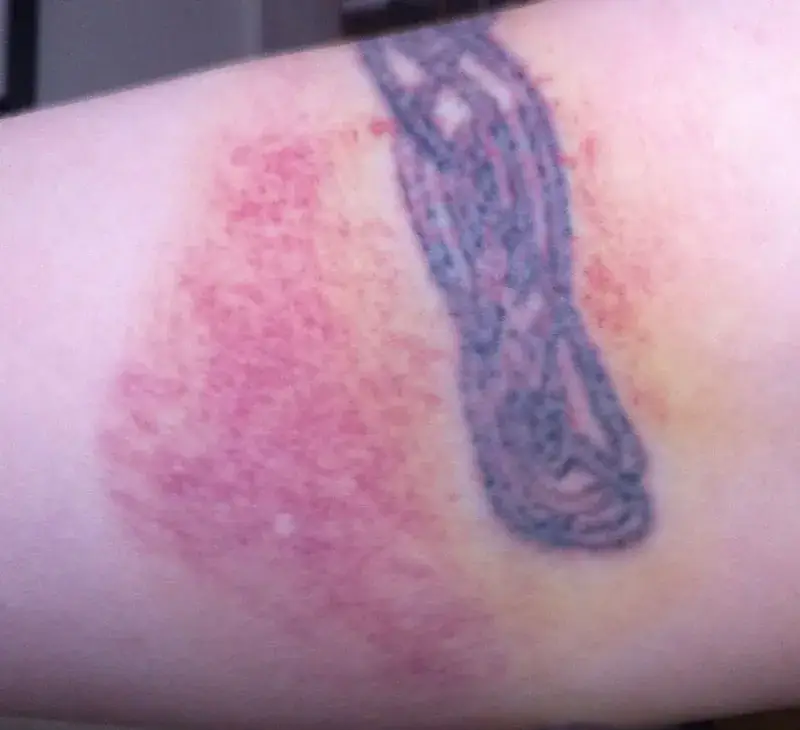
Skin Irritation and Redness
The skin around your new tattoo will look red and feel irritated. This immediate tattoo reaction happens because your immune system is responding to the ink and the trauma from the needle. The redness should start fading after a few days.
Infection Risks: When Bacteria and Viruses Become a Problem
Bacterial Tattoo Infections
Tattoo infections are one of the most serious risks you face when getting body art. Bacterial infections can happen if:
- The tattoo equipment isn’t properly sterilized
- The tattoo shop doesn’t follow clean procedures
- You don’t take care of your tattoo properly during healing
Common bacteria that cause tattoo infections include Staphylococcus (staph) and Streptococcus (strep). These tattoo bacteria can enter through the broken skin and multiply quickly if conditions are right.
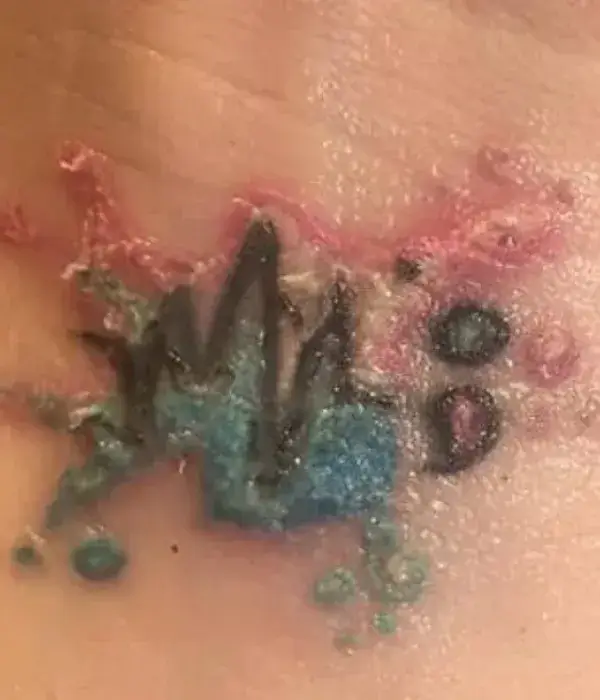
Viral Infections: Serious Health Risks
More serious viral infections can spread through contaminated needles or ink. The most concerning viruses include:
Hepatitis B and C: These viruses attack your liver and can cause long-term health problems. Hepatitis spreads through blood contact, which can happen if tattoo equipment isn’t properly sterilized between clients.
HIV: While rare, HIV transmission through tattooing can occur if infected blood gets into your system through contaminated needles or equipment.
Warning Signs of Tattoo Infection
Watch for these signs that might indicate a tattoo infection:
- Fever or feeling sick all over
- Red streaks extending from the tattoo
- Pus or unusual discharge (especially if it smells bad)
- Excessive swelling that gets worse instead of better
- Heat radiating from the tattoo area
- Severe pain that increases over time
If you notice any of these symptoms, see a doctor immediately. Early treatment can prevent serious complications.
Allergic Reactions: When Your Body Rejects Tattoo Ink
Common Ink Allergies
Some people develop allergic reactions to tattoo ink, especially certain colors. Red and yellow pigments cause the most ink allergic reactions, but any color can potentially trigger an allergy. The reaction happens because your immune system sees the ink as a foreign substance and tries to fight it off.
Types of Skin Sensitivity Reactions
Tattoo allergies can show up in different ways:
- Itchy, raised bumps around the tattooed area
- Scaly or flaky skin that won’t heal properly
- Persistent redness that doesn’t fade
- Small blisters or hives on or near the tattoo
Delayed Allergic Responses
Not all tattoo allergies happen right away. Some people develop reactions weeks, months, or even years after getting their tattoo. This delayed response can be confusing because you might not connect the reaction to your old tattoo.
Delayed reactions often happen when:
- Your immune system changes due to illness or medication
- You’re exposed to sunlight (some inks become more reactive in UV light)
- Your body’s sensitivity to the ink increases over time
Long-term Complications: Problems That Can Develop Later
Scarring and Keloid Formation
Some people are prone to developing thick, raised scars called keloids. If you’re someone who scars easily, you have a higher risk of tattoo scarring. Keloids can form months after your tattoo heals and may continue growing larger than the original tattoo.
Factors that increase scarring risk include:
- Family history of keloid scars
- Darker skin tones (higher natural risk)
- Getting tattoos on areas prone to tension (shoulders, chest)
- Poor aftercare during healing
Granulomas: Bumpy Skin Reactions
Granulomas are small, bumpy areas that can form around tattoo ink particles. Your immune system creates these bumps when it tries to isolate foreign materials (the tattoo ink) that it can’t remove from your body. These long-term tattoo effects usually aren’t dangerous, but they can make your tattoo look and feel bumpy.
MRI Complications
Some tattoo inks contain metals that can react during MRI scans. While rare, this can cause:
- Burning or tingling sensations during the scan
- Swelling around the tattooed area
- Temporary skin irritation
Always tell your doctor about your tattoos before any MRI procedure.
Skin Cancer Concerns
There’s ongoing research about whether tattoo ink might increase skin cancer risk. While current evidence doesn’t show a strong link, it’s important to:
- Monitor your tattooed skin for any unusual changes
- Protect tattoos from sun exposure
- Have regular skin checks with a dermatologist
The key to avoiding most of these problems is choosing a reputable tattoo artist who follows proper safety procedures and taking good care of your tattoo during the healing process.
What to Do When Tattoo Problems Occur: Treatment and Recovery Guide
Even with the best care, sometimes tattoo complications happen. Knowing how to recognize problems early and get the right treatment can save you from serious health issues and protect your tattoo investment. Here’s your complete guide to handling tattoo problems when they arise.
Recognizing Warning Signs: Normal vs. Abnormal Tattoo Healing
What Normal Tattoo Healing Looks Like
Understanding normal healing helps you spot when something’s wrong. A healthy healing tattoo typically goes through these stages:
Days 1-3: Your tattoo will be red, swollen, and tender. Some clear fluid or light bleeding is normal. The area feels warm and looks shiny.
Days 4-7: Redness starts fading, and your tattoo may feel tight or itchy. A thin scab or peeling skin develops – this is normal and expected.
Days 8-14: Scabs fall off naturally, revealing duller-looking skin underneath. Itching continues but swelling should be mostly gone.
Weeks 3-4: Your tattoo looks more settled, though it may still appear slightly cloudy as the final healing happens.
When to See a Doctor: Red Flag Symptoms
Some symptoms mean you need medical attention right away. Don’t wait or hope these problems will go away on their own:
Infection Warning Signs:
- Fever of 100.4°F (38°C) or higher
- Red streaks spreading away from your tattoo
- Pus that’s yellow, green, or has a bad smell
- Swelling that gets worse after day 3
- Severe pain that increases instead of decreasing
Allergic Reaction Symptoms:
- Raised, itchy bumps that don’t improve after a week
- Severe itching that interferes with sleep
- Blistering or hives around the tattoo
- Difficulty breathing (rare but serious)
Emergency Symptoms: Seek Immediate Care
Go to the emergency room or call 911 if you experience:
- High fever with chills and confusion
- Rapid spreading of red streaks
- Severe difficulty breathing or swallowing
- Signs of blood poisoning (sepsis)
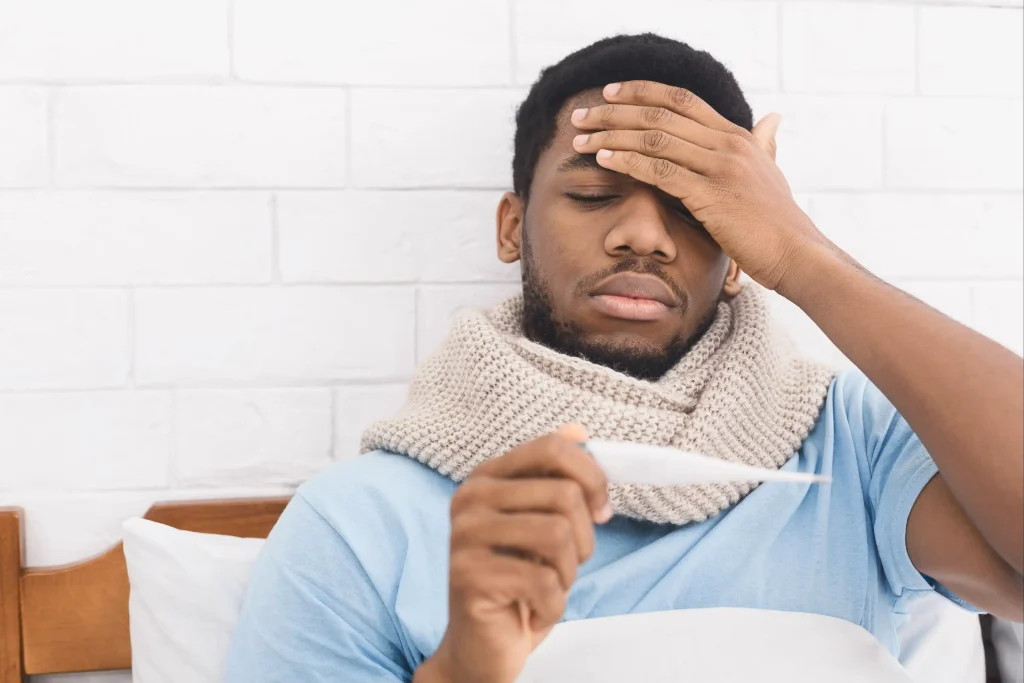
These symptoms can indicate life-threatening complications that need immediate medical intervention.
Treatment Options: How to Handle Different Tattoo Complications
Medical Treatments for Tattoo Infections
Antibiotic Treatment: Most bacterial tattoo infections respond well to antibiotics. Your doctor might prescribe:
- Topical antibiotic creams for mild skin infections
- Oral antibiotics for moderate infections
- IV antibiotics for severe or spreading infections
Proper Wound Care: Along with antibiotics, tattoo infection treatment includes:
- Gentle cleaning with antibacterial soap
- Applying prescribed topical medications
- Keeping the area dry and covered when needed
- Avoiding tight clothing that rubs the infected area
Follow-up Care: Your doctor will want to check your progress. Most infections clear up within 7-10 days with proper treatment, but some cases need longer antibiotic courses.
Managing Allergic Reactions to Tattoo Ink
Antihistamines: For mild allergic reactions, over-the-counter antihistamines like Benadryl can help reduce itching and swelling.
Topical Steroids: Your doctor might prescribe steroid creams to reduce inflammation and calm your immune system’s reaction to the ink.
Oral Medications: Severe reactions may require oral steroids or other medications to control the allergic response.
Avoiding Triggers: If sunlight makes your reaction worse, protect your tattoo from UV rays. Some people find that certain soaps or lotions worsen their symptoms.
Professional Scar Treatment Options
If your tattoo develops keloid scars or thick scar tissue, several tattoo treatment options are available:
Steroid Injections: Doctors can inject steroids directly into keloid scars to help flatten and soften them.
Laser Therapy: Specialized lasers can help reduce scar tissue and improve the appearance of scarred tattoos.
Surgical Removal: In severe cases, surgically removing keloid tissue might be necessary, though this carries risks of new scar formation.
Tattoo Removal Options
When problems can’t be resolved, removing the tattoo might be the best solution:
Laser Removal: The most common method uses laser energy to break up ink particles so your body can eliminate them naturally. This process takes multiple sessions over months or years.
Dermabrasion: This older method involves sanding away skin layers. It’s less common now due to scarring risks.
Surgical Excision: Complete surgical removal might be needed for severe reactions, but this leaves a scar.
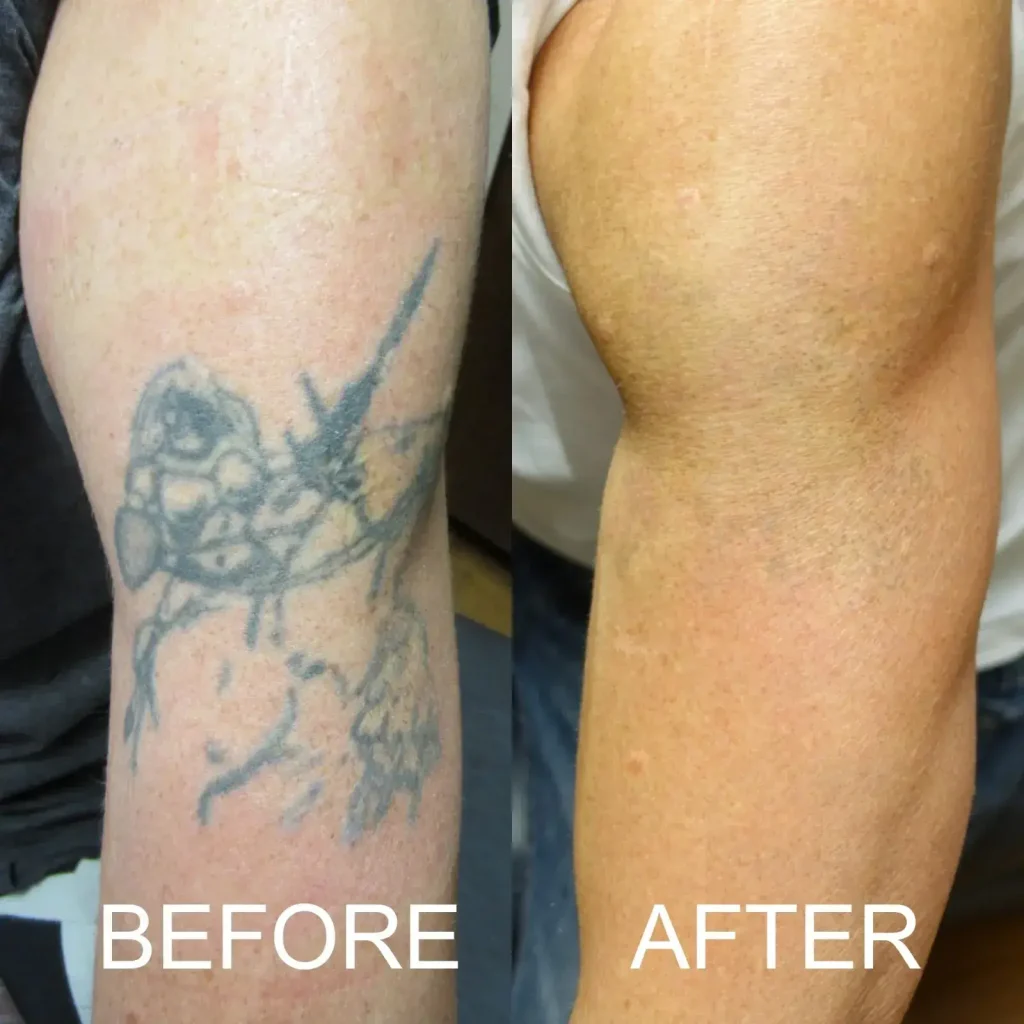
When to Seek Professional Help: Getting the Right Medical Care
Your Regular Healthcare Provider
Start with your family doctor or primary care physician for:
- Signs of infection that aren’t severe
- Questions about normal vs. abnormal healing
- Initial treatment of mild allergic reactions
- Referrals to specialists when needed
Most doctors can handle basic tattoo complications and will know when to refer you to a specialist.
Dermatologist Referrals: Skin Specialist Care
See a dermatologist (skin doctor) for:
- Persistent allergic reactions that don’t respond to basic treatment
- Keloid scars or unusual scar formation
- Skin changes that might indicate more serious problems
- Long-term management of chronic tattoo reactions
Dermatologists have specialized training in skin conditions and access to advanced treatments.
Emergency Care Situations
Go to the emergency room immediately if you have:
- High fever with severe illness symptoms
- Signs of blood poisoning (confusion, rapid heartbeat, difficulty breathing)
- Severe allergic reactions affecting your whole body
- Rapidly spreading infection with red streaks
Remember: It’s always better to seek medical attention too early rather than too late. Most tattoo problems are easily treatable when caught early, but they can become serious if ignored.
Don’t let embarrassment or cost concerns prevent you from getting medical help. Healthcare providers see tattoo complications regularly and are there to help you heal safely.
How to Get a Safe, Healthy Tattoo: Your Complete Prevention Guide
The best way to avoid tattoo problems is to prevent them from happening in the first place. Getting a safe, healthy tattoo starts with choosing the right shop and artist, preparing properly, and following good aftercare practices. Here’s everything you need to know to protect yourself and get the best possible results.
Choosing the Right Tattoo Shop: Your First Line of Defense
Licensed and Certified Artists: Verify Credentials
A safe tattoo shop starts with properly trained artists. Here’s what to look for:
Check for Valid Licenses: Every tattoo artist should have a current license displayed in their work area. These licenses show the artist has completed required health and safety training. Don’t be shy about asking to see licenses if they’re not visible.
Professional Certifications: Look for artists who have completed bloodborne pathogen training and CPR certification. Many reputable artists also attend workshops and conventions to stay current with best practices.
Portfolio and Experience: A skilled artist will have a portfolio showing their work quality and style range. Ask how long they’ve been tattooing and what their specialties are. Experience matters for both artistic skill and safety procedures.
Clean, Sterile Environment: What a Safe Tattoo Shop Looks Like
When you walk into a tattoo shop, you should immediately notice cleanliness and organization. Here’s your tattoo shop safety checklist:
Overall Cleanliness:
- Floors, walls, and surfaces should be spotless
- No clutter or unnecessary items in work areas
- Clean bathrooms and waiting areas
- Fresh, clean smell (not musty or chemical odors)
Work Station Setup:
- Each artist should have their own clean, organized station
- Disposable items like gloves, razors, and ink caps should be unopened
- Reusable equipment should look clean and well-maintained
- Hand-washing station or sanitizer easily accessible
Sterilization Equipment:
- An autoclave (sterilization machine) should be visible and in working order
- Spore test strips or certificates showing the autoclave works properly
- Ultrasonic cleaner for pre-sterilization cleaning
- Proper storage for sterilized equipment
Proper Equipment and Sterilization: Technical Safety Standards
Single-Use Items: These should always be new and opened in front of you:
- Needles and needle cartridges
- Ink caps and ink
- Razors for shaving
- Gloves and protective barriers
Sterilizable Equipment: Items like tattoo machines, grips, and tubes should be:
- Properly cleaned after each use
- Sterilized in an autoclave between clients
- Stored in sterile pouches until use
- Opened in your presence
Red Flags to Avoid:
- Reusing needles or disposable items
- Equipment that looks dirty or rusty
- No visible sterilization process
- Artists who seem careless about cleanliness
Pre-Tattoo Preparation: Setting Yourself Up for Success
Health Considerations Before Getting a Tattoo
Your health status greatly affects how well your tattoo heals. Consider these factors during your tattoo preparation:
Medical Conditions to Discuss:
- Diabetes (affects healing and infection risk)
- Heart conditions (especially if you take blood thinners)
- Autoimmune disorders (may affect healing)
- Skin conditions like eczema or psoriasis
- Recent illness or feeling unwell
Medications That Matter:
- Blood thinners increase bleeding risk
- Immune-suppressing drugs affect healing
- Some acne medications make skin more sensitive
- Pain medications might not mix well with tattoo pain
When to Postpone Your Tattoo:
- If you’re feeling sick or have a fever
- During pregnancy or while breastfeeding
- If you have active skin infections
- After recent sunburn in the tattoo area
Skin Preparation: Getting Your Canvas Ready
Proper skin prep before getting a tattoo helps ensure better results and faster healing:
In the Weeks Before:
- Keep your skin moisturized and healthy
- Avoid excessive sun exposure to the tattoo area
- Don’t start new skincare products that might cause reactions
- Stay hydrated and eat nutritious foods
The Day Before Getting a Tattoo:
- Get a good night’s sleep (your body heals better when rested)
- Avoid alcohol and recreational drugs
- Don’t take aspirin or other blood-thinning medications unless medically necessary
- Shower and clean the area thoroughly
Day of Your Appointment:
- Eat a substantial meal before your session
- Wear comfortable, loose-fitting clothes
- Bring snacks and water for longer sessions
- Arrive on time and relaxed
What to Avoid Before Getting Tattooed
These substances and activities can increase your risk of complications:
24-48 Hours Before:
- Alcohol (increases bleeding and affects judgment)
- Aspirin or ibuprofen (increases bleeding risk)
- Energy drinks or excessive caffeine
- Sunbathing or tanning beds
One Week Before:
- Starting new medications (unless necessary)
- Trying new skincare products on the tattoo area
- Getting other body modifications in the same area
- Excessive exercise that might dehydrate you
During the Tattoo Process: Safety Standards to Expect
Sterile Procedures: What Should Happen During Your Session
When you’re getting tattooed, you should see these tattoo process safety measures:
Before Starting:
- Artist washes hands thoroughly and puts on fresh gloves
- Skin is cleaned and shaved with new, disposable razors
- Stencil is applied with clean hands and materials
- Work area is covered with disposable barriers
During the Tattoo:
- Artist changes gloves if they touch anything non-sterile
- New needles and equipment are used only for your tattoo
- Ink is poured into disposable caps, never double-dipped
- Artist follows proper sterile tattooing techniques throughout
Quality Ink and Equipment: What to Look For
Professional Tattoo Ink:
- Reputable brands with safety certifications
- Fresh ink poured from new bottles
- Proper color saturation and consistency
- Artist can tell you the ink brand and type
Quality Tattoo Equipment:
- Modern, well-maintained tattoo machines
- Consistent needle depth and speed
- Proper needle configuration for the work being done
- Equipment that sounds and operates smoothly
Red Flags During Your Tattoo Session
Stop the session immediately if you notice:
- Artist reusing needles or equipment
- Dirty or contaminated work surfaces
- Artist not wearing gloves or changing contaminated gloves
- Poor hygiene practices
- Equipment that seems to malfunction
Trust your instincts. If something doesn’t feel right, it’s better to leave and find a better shop than risk your health.
Aftercare Best Practices: Protecting Your Investment
Proper Cleaning Techniques for New Tattoos
Good tattoo aftercare starts immediately after your session ends:
First 24 Hours:
- Keep the bandage on for 2-4 hours (follow your artist’s instructions)
- Wash your hands before touching your tattoo
- Gently clean with lukewarm water and antibacterial soap
- Pat dry with a clean paper towel (not cloth towels)
Daily Cleaning Routine:
- Wash 2-3 times per day with gentle, unscented soap
- Use lukewarm water, never hot water
- Gently pat dry, never rub or scrub
- Apply a thin layer of recommended aftercare product
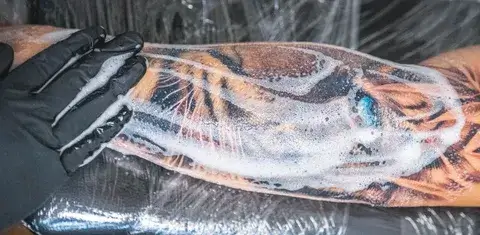
Moisturizing and Protection: Healing Support
Recommended Products:
- Unscented, gentle moisturizers
- Products specifically designed for tattoo healing
- Avoid petroleum-based products that can clog pores
- Never use products with alcohol, fragrances, or harsh chemicals
Application Tips:
- Use clean hands to apply products
- Apply thin layers, don’t over-moisturize
- Let your skin breathe between applications
- Listen to your artist’s specific product recommendations
Activities to Avoid During Tattoo Healing
Protect your healing tattoo by avoiding these activities:
For the First 2 Weeks:
- Swimming in pools, lakes, or oceans
- Soaking in bathtubs or hot tubs
- Excessive sweating from intense exercise
- Direct sunlight exposure
- Tight clothing that rubs the tattoo
Until Fully Healed (4-6 weeks):
- Picking or scratching at scabs
- Using harsh soaps or exfoliants
- Tanning beds or prolonged sun exposure
- Contact sports or activities that might damage the tattoo
Healing Timeline Expectations: What’s Normal
Understanding normal tattoo healing helps you provide proper tattoo care tips:
Week 1: Redness, swelling, and tenderness are normal. Light scabbing begins.
Week 2: Scabs start falling off naturally. Itching is common but don’t scratch.
Week 3-4: Most scabbing is gone, but skin may look dull or cloudy.
Week 4-6: Final healing occurs, and your tattoo should look clear and vibrant.
Remember, healing times vary based on tattoo size, location, and your individual healing rate. Following proper aftercare guidelines ensures the best possible outcome for your new tattoo.
By choosing a reputable shop, preparing properly, and following good aftercare practices, you can significantly reduce your risk of complications and enjoy your tattoo for years to come.
Technology and Safety Innovations: How Modern Tech Makes Tattoos Safer
The tattoo industry has embraced cutting-edge technology to make the art of tattooing safer, more precise, and more hygienic than ever before. From advanced sterilization systems to smart tattoo machines, modern tattoo technology is revolutionizing how artists work and how clients heal.
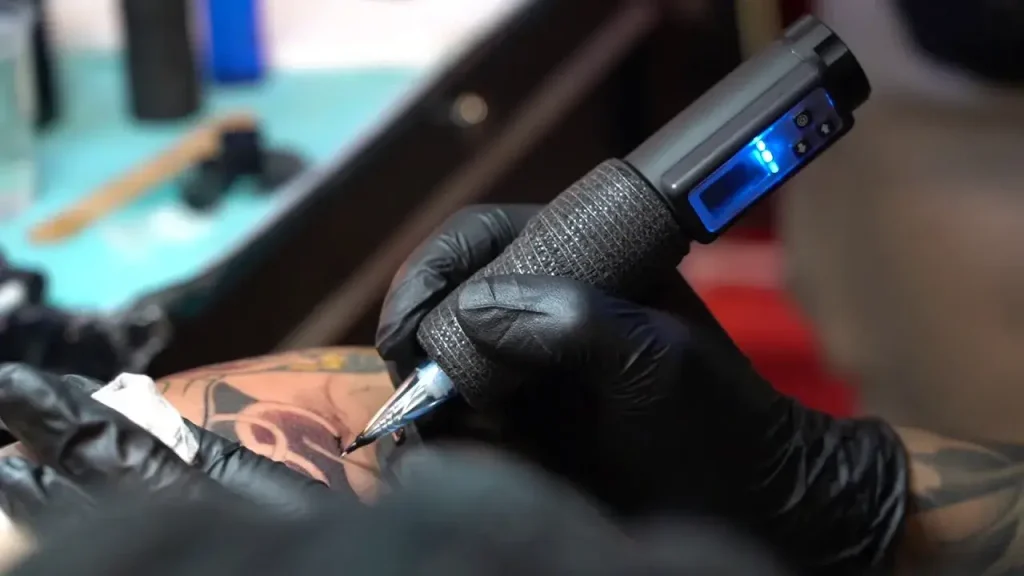
Modern Sterilization Technology: Beyond Traditional Methods
Advanced Autoclave Systems
Today’s tattoo shops use sophisticated sterilization equipment that goes far beyond basic cleaning methods:
Digital Autoclave Monitoring: Modern autoclaves feature digital displays that track temperature, pressure, and sterilization time with precision. These systems automatically document each sterilization cycle, creating permanent records for safety compliance.
Biological Indicator Testing: Advanced sterilization technology now includes biological spore strips that prove equipment is actually sterile, not just heated. These indicators change color when proper sterilization occurs, giving artists and clients confidence in safety protocols.
Vacuum-Assisted Sterilization: New autoclave systems use powerful vacuum pumps to remove air more effectively, ensuring steam penetrates every surface of tattoo equipment. This technology eliminates bacteria and viruses more reliably than older methods.
UV-C Disinfection Systems
Some forward-thinking shops now use UV-C light technology to disinfect work surfaces and tools. These systems use specific wavelengths of ultraviolet light that destroy bacteria, viruses, and other pathogens without using chemicals.
Advanced Tattoo Equipment: Precision Meets Safety
Smart Tattoo Machines
Modern tattoo equipment incorporates digital technology for better control and safety:
Digital Power Supplies: New tattoo machines use microprocessor-controlled power supplies that maintain consistent voltage and speed. This precision reduces skin trauma and creates more even ink application, leading to better healing.
Wireless Tattoo Machines: Battery-powered wireless machines eliminate cord contamination risks and give artists better freedom of movement. These machines often include LED displays showing battery life, voltage, and needle speed.
Cartridge Needle Systems: Modern tattoo technology has largely replaced traditional needle setups with disposable cartridge systems. These cartridges click directly into the machine, reducing contamination risk and ensuring each client gets completely sterile needles.
Improved Safety Features
Needle Depth Control: Advanced machines now offer precise needle depth adjustment, preventing artists from going too deep and reducing scarring risk. Some systems even include automatic depth limiting to prevent accidents.
Vibration Dampening: New machine designs reduce vibration and noise, making the tattooing process more comfortable for clients and reducing hand fatigue for artists during long sessions.
New Ink Formulations: Safer Chemistry for Better Results
Organic and Vegan Ink Options
The tattoo industry has developed safer ink formulations that reduce allergic reaction risks:
Heavy Metal-Free Inks: Traditional tattoo inks often contained heavy metals like mercury and lead. New formulations eliminate these toxic materials while maintaining vibrant colors that last longer.
Organic Pigment Technology: Modern inks use organic pigments derived from safer sources. These inks are less likely to cause allergic reactions and break down more predictably in the body over time.
Vegan-Certified Inks: Many new ink brands are completely vegan, eliminating animal-derived ingredients that some people’s immune systems reject. These formulations are often gentler on sensitive skin.
Smart Ink Innovations
UV-Reactive Inks: Some new inks only become visible under ultraviolet light, opening new creative possibilities while using safer chemical compositions than older specialty inks.
Biodegradable Formulations: Researchers are developing inks designed to break down safely in the body over time, potentially making tattoo removal easier and safer in the future.
Digital Tattoo Design Tools: Technology Meets Artistry
Computer-Aided Design Software
Modern tattoo artists use sophisticated software to create and modify designs:
3D Design Preview: Advanced programs let clients see how tattoos will look on their actual body shape before getting inked. This technology reduces the chance of regret and helps artists place designs more accurately.
Color Matching Technology: Digital tools can analyze skin tone and recommend ink colors that will look best and age well on individual clients.
Augmented Reality Applications
Virtual Tattoo Try-On: AR apps let people see realistic tattoo previews on their skin using smartphone cameras. This technology helps clients make better decisions about size, placement, and design.
Stencil Projection Systems: Some shops now use digital projectors to place tattoo stencils with perfect precision, reducing the need for multiple stencil applications and improving accuracy.
These technological advances make getting a tattoo safer and more precise than ever before. When choosing a tattoo shop, look for one that embraces modern tattoo technology while maintaining traditional artistic skills.
Expert Tips for Tattoo Safety: Your Complete Pre-Tattoo Checklist
Getting a safe tattoo requires careful planning and smart decision-making. These expert tattoo safety tips from industry professionals will help you avoid common mistakes and ensure the best possible experience.
Safe Tattoo Checklist: What to Look for in a Tattoo Artist
Artist Qualifications and Experience
Portfolio Review:
- Look for consistent, clean line work across different styles
- Check for proper shading and color saturation in healed tattoos
- Ask to see photos of tattoos after they’ve fully healed (not just fresh work)
- Ensure the artist’s style matches what you want
Professional Credentials:
- Valid tattoo license displayed prominently
- Bloodborne pathogen certification
- First aid/CPR training certificates
- Professional association memberships
Shop Reputation:
- Read recent online reviews from multiple sources
- Ask friends and family for personal recommendations
- Check social media for customer feedback and recent work
- Look for any health department violations or complaints
Health and Safety Standards Assessment
Cleanliness Inspection:
- Spotless work area with no clutter
- Fresh disposable covers on all surfaces
- Proper hand-washing facilities available
- Clean, organized supply storage
Equipment Verification:
- Working autoclave with recent spore test results
- New, sealed needles and ink cups opened in front of you
- Modern, well-maintained tattoo machines
- Disposable razors and gloves used for each client
Essential Questions to Ask Before Getting Tattooed
Health and Safety Questions
Before committing to any artist, ask these important questions:
“Can I see your sterilization process?” A reputable artist will gladly show you their autoclave and explain their safety procedures.
“What type of ink do you use?” Professional artists use high-quality, reputable ink brands and can tell you exactly what’s in them.
“How do you handle allergic reactions?” Experienced artists should have protocols for managing complications and know when to recommend medical care.
“What’s your policy on touch-ups?” Most reputable artists offer free touch-ups within a reasonable time frame if healing issues occur.
Process and Aftercare Questions
“What aftercare products do you recommend?” Professional artists provide detailed aftercare instructions and product recommendations.
“How long will this tattoo take to heal?” Artists should give you realistic healing timeframes based on your tattoo’s size and location.
“What should I do if I notice signs of infection?” Make sure your artist can explain warning signs and knows when to refer you to medical professionals.
Budget Considerations: Why Cheap Tattoos Cost More
The True Cost of Going Cheap
Quality Compromises: Discount tattoo shops often cut corners on essential safety measures. They might reuse equipment, use low-quality inks, or skip proper sterilization procedures to keep costs low. These shortcuts can lead to infections, poor healing, and disappointing results.
Hidden Long-term Costs: A cheap tattoo that gets infected might require expensive medical treatment. Poor-quality work often needs costly cover-up tattoos or laser removal later. Professional touch-ups and corrections can cost more than getting quality work initially.
Smart Budgeting for Safe Tattoos
Research Average Pricing: Quality tattoo work typically costs $100-200 per hour, depending on your location and the artist’s experience level. Extremely low prices should raise red flags about safety standards.
Save for Quality: It’s better to wait and save money for a reputable artist than to rush into a cheap tattoo. A quality tattoo is a lifelong investment that deserves proper funding.
Consider Value, Not Just Price: Factor in the artist’s experience, shop cleanliness, safety standards, and aftercare support when comparing prices. The cheapest option rarely offers the best value.
Payment Plans: Many reputable shops offer payment plans for larger pieces. This lets you get quality work while managing your budget responsibly.
Remember, tattoos are permanent body modifications that affect your health and appearance. Following these tattoo safety tips and using this safe tattoo checklist helps ensure you make smart decisions that you’ll be happy with for years to come.
Conclusion: Your Path to Safe Tattooing Success
Getting a tattoo safely isn’t complicated, but it does require knowledge and careful planning. By understanding the potential risks and taking proper precautions, you can significantly reduce your chances of complications while getting beautiful body art you’ll love for years to come.
Key Takeaways for Safe Tattooing
The most important tattoo safety points to remember are choosing a licensed, reputable artist who follows strict hygiene standards, preparing your body properly before your appointment, and following detailed aftercare instructions during healing. Modern tattoo technology has made the process safer than ever, but your choices as a client remain the biggest factor in your success.
Remember that infections, allergic reactions, and other complications are largely preventable when you do your research and don’t cut corners on safety. Warning signs like fever, spreading redness, or unusual discharge require immediate medical attention – never ignore symptoms hoping they’ll go away on their own.
Make Smart Decisions About Your Tattoo Journey
Quality tattoo work is an investment in both your health and appearance. Take time to research artists, visit shops in person, and ask detailed questions about safety procedures. Don’t let budget constraints push you toward unsafe options that could cost far more in medical bills or correction work later.
Use the checklists and safety tips in this guide to evaluate potential tattoo artists and shops. Trust your instincts – if something doesn’t feel right about a shop’s cleanliness or an artist’s practices, find someone else.
Your health and safety should always come first when getting tattooed. With proper preparation and smart choices, you can enjoy the tattoo experience while minimizing risks and maximizing your chances of excellent results that you’ll be proud to show off.
